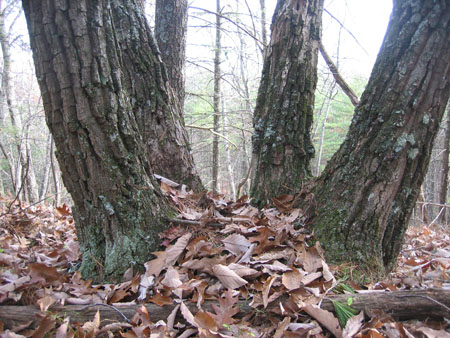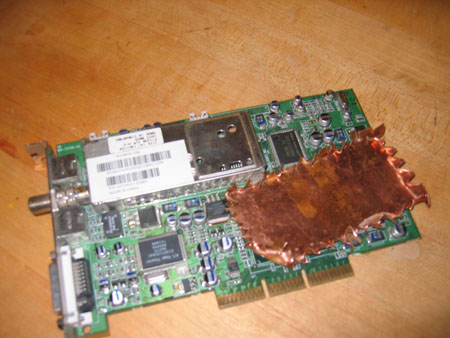|
|
|
still life with coyotes
Monday, November 21 2005
I returned from a Woodstock housecall today to find an obviously troubled Gretchen just returning from her morning walk in the woods with the dogs. She told me to grab my camera and follow her. Oh shit, what could it possibly be? "Is it a dead deer?" I asked. "No," she said. "Is it a live deer then?" "No." We're in the early, most enthusiastic days of hunting season now and there are lots of morons in the woods getting drunk and committing crimes against nature. Last year I found a dead doe deer that had been illegally shot and abandoned for the coyotes only a quarter mile from the house. That Gretchen had nixed the notion that it was a deer implied that whatever she was leading me to must be a similarly grave atrocity: a dead bear or, worse, an unexpected tract of McMansions. Some distance down the Stick Trail I declared, "I don't understand why all the mystery." "I want you to be surprised just the way I was," Gretchen said.
Somewhat less than a mile down the Stick Trail, there it was, the atrocity. Unlike Gretchen, though, I was looking for it and expecting the worse. Sally actually got to it first and alerted us to it by barking, an act she reserves for only the most fucked-up of situations. And it was horrible. Two coyotes, looking much like German Shepherds but with more angular faces, had been shot and then arranged in a still life in the low crotches of a cluster of 50 year old Chestnut Oak sprouts right on the edge of the trail. They both faced the trail at similar angles and were mirror images of each other. Where they differed was their injuries. One of the front paws of one of the coyotes had been shot almost completely off and hung by a flap of skin. Blood from the injury stained the paw pink. It also had a large hole in the back of the neck. The other coyote had suffered severe internal injuries from a bullet passing through its body and blood had once poured from both its mouth and asshole. Whoever had shot these coyotes was evidently proud of his work against the dark forces of nature and had arranged his victims here along the trail as a triumphal display of marksmanship and good citizenship. We, of course, didn't react to this gruesome display with the nervous sighs of gratitude expected. Instead Gretchen started wailing, "Why? Why? What did these creatures do? They're dogs, just like Sally and Eleanor, just trying to go about their lives! I petted them and their fur is so soft!" The most depressing thing about this whole display wasn't just its demonstration that we have to share a world with sadistic meatheads and their constitutionally-protected (though completely anachronistic) toys of death. It was that that it had forever destroyed the innocence of this stretch of trail. About the only thing I could do to redeem the moment was take pictures and them drag the coyotes off the trail and lay them on a peaceful patch of pine needles and oak leaves about 100 feet west of the trail. They weighed about fifty pounds each.
The vision of those coyotes haunted me the rest of the day. I imagined them happily running through the woods one moment, playfully tackling and chasing each other, and then cut down in an instant by gunfire. For us, it's the woods of Upstate New York, but for them it's fucking Iraq. How long before they died? How far had they been dragged to the Appian Way of their display? What vaguely artistic thoughts lit up the weakly-firing neurons of their murderer?
Later today I got my electronic "solar sufficiency circuit" working exactly as I wanted in the laboratory. But then, down in the basement, in the real world, it failed completely. It turned out that the "high voltage" of the the laboratory was 12 volts, whereas the "high voltage" in the boiler room (which I'd never bothered to test and which I'd assumed was about 24 volts - the rating of the relays and boiler valves - was actually 38 volts. Evidently this was too much for the power transistors, which lasted only about 30 seconds. Now I needed to find something to replace them. Luckily, I soon found a ULN2003 chip on an old household burglar alarm circuit board, and (according to its specs) it would meet my needs perfectly. I'd never heard of the chip before, mind you, and only learned what it did with the assistance of Google. (Before the rise of the Internet, I used to write down the numbers of unknown scavenged integrated circuits on pieces of paper and then, perhaps weeks later, look them up in technical manuals in the stacks of a university library, preferably a technical one like Virginia Tech.)
For the past couple weeks Woodchuck (my main Windows computer) has been making an annoying moaning noise that I knew was coming from one of its fans. But which fan? Astute readers will remember how I tried to find the answer by stopping each fan with a screwdriver and seeing if the noise stopped, shattering the CPU fan in the process. Eventually I determined that the noisy fan was on the graphics processor of the ATI All in Wonder Radeon card, a nearly four year old video card. It's a tiny fan, and I remember thinking when I first bought the card, "That fan will go bad some day and I'll have to figure out a replacement." Back then I was aware that finding big processor and power supply fans is easy, but that tiny fans that must fit on plug-in cards are a completely different matter. I'm certain that one of the selling points ATI engineers had when introducing a fan to their product was that, as a mechanical device, it would limit the effective life of the card (a form of planned obsolescence), thereby coercing replacement sales down the road.
In terms of technology, the four year old ATI card is perfectly adequate for my needs and I have no desire to replace it. So I decided to remove the fan and install a solution that would never wear out: a huge heat sink made of thick copper sheeting. The resulting heat sink was about three inches long by an inch and a half wide and featured a bent, fringed margin sticking up about a quarter inch. It barely fit in the available room, and I had to attach it with heat sink compound and two different kinds of glue. But it seemed to do its job perfectly fine. The ATI card lives on.

The coyotes along the Stick Trail, the way we found them.

The coyotes in their final resting place with Sally.

The Chestnut Oak without the coyotes. The stick in the foreground defines the edge of the Stick Trail.

The sufficiency circuit, as I attempted to install it today. The fate of those transistors was sealed. Note the four potentiometers along the top allowing me to adjust temperature sufficiency cutoffs and cut-ons for both the slab and hot water solar loops.

The new copper heat sink I made for my four year old ATI video card.
For linking purposes this article's URL is:
http://asecular.com/blog.php?051121 feedback
previous | next |




